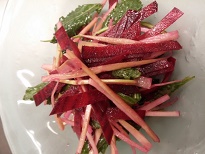 CAPE ELIZABETH, MAINE—The Inn by the Sea’s Sea Glass Chef Mitchell Kaldrovich learned most of what he thinks is important from his grandmother, helping her cook family dinners when a boy in his native Argentina. “Nothing went to waste,” says Kaldrovich. “You bake bread today, tomorrow you make bread pudding. My grandmother respected local farmers and fishermen too much to waste the food they produced.”
CAPE ELIZABETH, MAINE—The Inn by the Sea’s Sea Glass Chef Mitchell Kaldrovich learned most of what he thinks is important from his grandmother, helping her cook family dinners when a boy in his native Argentina. “Nothing went to waste,” says Kaldrovich. “You bake bread today, tomorrow you make bread pudding. My grandmother respected local farmers and fishermen too much to waste the food they produced.”
Early lessons feed the chef’s enthusiasm for the Root to Stalk movement. A long time advocate for farm to fork, trawl to table and fresh seasonal menus, the chef sees the culinary sense of using up the entire vegetable when possible, rather than tossing stalks, stems, fronds or leaves into the compost bin.
“Rather than using just the florets, a thin slice of a whole broccoli lightly grilled, with stems intact, is delicious, healthy and beautiful on the plate,” states the Chef. “Presenting the entire vegetable brings attention to simple, lighter fare with an appreciation for the whole plant.” It elevates the vegetable from a side to focal point on the plate just as more guests in Sea Glass are requesting vegetarian or vegan menu options and focused on health.”
Approach Reduces Waste
Root to Stalk makes sense from a “waste not” view. With global studies showing 40 to 50 percent of food produced being wasted, using it all up is better for the planet.
But it isn’t just about a counter culture to food waste, according to Kaldrovich. The Root to Stalk trend pushes chefs to find culinary gems in what was formally relegated to the compost bin. “Leaves, stalks, fronds and roots can introduce new, sometimes earthy pungent flavors, a crunchy texture, or a new presentation that opens doors to delicious recipes, inventive menus or a visually appealing culinary experience,” he says.
Beets are a favorite in Sea Glass. Beet tips are used for vinaigrette, great for salads but also used by the pastry chef in red velvet chocolate cakes. Braised beet greens, as well as radish leaves, are treated like kale, while the beet itself is marinated, braised for salads, roasted and added to quinoa. Used raw, beets are sliced thin like a radish to add a crunchy texture, or fried for delicious, colorful chips. The chef’s summer menu features beet slaw with peeled, thinly sliced broccoli stems, tender broccoli leaves and light vinaigrette.
Most people are familiar with carrot and celery fronds and leaves, and view them as worthless, but Kaldrovich uses them both in soups and salads, or to make salsa. “They can be bitter but are very healthy and, used sparingly add flavor to soups, a mixed salad or slaw and are good in chimichurri.”
Meat & Seafood Also Included
The chef doesn’t limit Root to Stalk philosophy to vegetables—in Sea Glass the same concept applies whenever possible to meat, Gulf of Maine seafood and lobster. “Today, people are interested in good food that is also good for them,” says Kaldrovich. “They are focused on their health, but they also care about the health of the planet.”
Throwing edible food away wastes resources, such as water and energy used to grow, haul or catch the product, as well as energy from packaging and transport. Wasted food usually ends in the landfill, where it generates methane gas. In fact, no food is wasted at Sea Glass because local farmer John Tibbetts composts all food waste, and his rich soil amendment is put back into both farmers’ fields and the Inn’s gardens.
“Farmers were, as they are now, an important part of the community,” says Kaldrovich. “ My grandmother understood the hard work and resources it took to get good tasting, healthy food to table and she wasn’t about to waste any part of it.”
Go to Sea Glass at the Inn by the Sea.





